Williamsburgh Savings Bank Tower
The Williamsburgh Savings Bank Tower is a skyscraper located in Downtown Brooklyn, in the borough of Brooklyn, New York City. Located at 1 Hanson Place between Ashland Place and St. Felix Street, the tower is one of the borough's architectural icons. The tower was designed by Halsey, McCormack and Helmer and constructed from 1927 to 1929 as the new headquarters for the Williamsburgh Savings Bank.
| Williamsburgh Savings Bank Tower | |
|---|---|
Williamsburgh Savings Bank Tower (2010) | |

| |
| Alternative names | 1 Hanson Place |
| General information | |
| Status | Complete |
| Type | Residential |
| Architectural style | Neo-Romanesque |
| Address | 1 Hanson Place Brooklyn, New York 11243 |
| Coordinates | 40°41′8″N 73°58′40″W |
| Construction started | 1927 |
| Opened | April 1, 1929 |
| Renovated | 2006–2007 |
| Height | |
| Roof | 512 feet (156 m) |
| Technical details | |
| Floor count | 37 |
| Design and construction | |
| Architect | Halsey, McCormack and Helmer |
| Renovating team | |
| Renovating firm | H. Thomas O’Hara |
Prior to 2010, when it was surpassed by the Brooklyner, the Williamsburgh Savings Bank Tower was the tallest building in Brooklyn at 37 stories and 512 feet (156 m) tall.[lower-alpha 1] It is among the tallest four-sided clock towers in the world, and contains clock faces that are 17 feet (5.2 m) in diameter. The New York City Landmarks Preservation Commission designated the Williamsburgh Savings Bank Tower as an official city landmark in 1994. Since 2007, the building has been converted into luxury condominium apartments under the name 1 Hanson Place.
Site
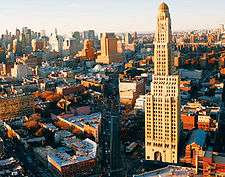
The building is located at 1 Hanson Place, at the corner of Ashland Place, near Times Plaza – the intersection of Atlantic, Flatbush, and Fourth Avenues – and close to the Atlantic Terminal mall, Atlantic Terminal LIRR station, and the Barclays Center. Despite its name it stands in the Fort Greene/Pacific Park sections of Brooklyn, rather than in Williamsburg, where the bank's original headquarters building by George B. Post still stands.[1]
Design
The building was constructed in a modernized Byzantine-Romanesque style.[2] It features a gilded copper dome; carved lions, turtles and birds on the exterior; and a marble banking hall on the ground floor with 63-foot (19 m) vaulted ceilings, 40-foot (12 m) windows and elaborate mosaics; and two abandoned public observation decks with signage describing the Battle of Brooklyn.[3][4]
Form
The building contains a balanced, though not symmetrical, vertical massing of staggered setbacks in buff-colored brick and architectural terracotta.[5]
The architects' plan for the new building did not include the Renaissance style dome on top, but the bank considered a dome such as the one on the original building to be its signature and insisted on one being added. Chief architect Robert Helmer noted: "Dome was required by Bank over our dead protests"[6] – with the familiar phallic result: the AIA Guide to New York City calls it "New York's most exuberant phallic symbol."[2] Helmer wrote at the time of the building's opening that he wanted it "to be regarded as a cathedral dedicated to the furtherance of thrift and prosperity."[6]
Facade
On the exterior a highly polished shoulder-height dado, veneered with veined and colored Minnesota granite,[7] presents a glistening variegated surface to the pedestrian passing at close distance and offers a discreet inscription near a corner:
TO OUR DEPOSITORS PAST AND PRESENT THIS BUILDING IS DEDICATED. BY THEIR INDUSTRY AND THRIFT THEY HAVE BUILT HOMES AND EDUCATED CHILDREN, OPENED THE DOOR OF OPPORTUNITY TO YOUTH AND MADE AGE COMFORTABLE INDEPENDENT AND DIGNIFIED. BY THOSE STURDY VIRTUES THEY HAVE OBTAINED THEIR AMBITIONS, SWEPT ASIDE THE PETTY DISTINCTIONS OF CLASS AND BIRTH AND SO MAINTAINED THE TRUE SPIRIT OF AMERICAN DEMOCRACY
Carved details around the windows are appealingly symbolic, in the vein of architecture parlante, speaking of the values of thrift with beehives, squirrels that store nuts, the head of Mercury, god of Commerce, wise owls, and seated lions whose paws protect the bank's lockbox, with the bank's monogram on the lock haft. Embedded in the ashlar wall face above are square bas-reliefs, one on the right of a burglar, whom the depositor understood would be thwarted by the massive vault doors in the basement.[6]
Interior
Ground floor

The low vaulted ceiling of the narthex-like vestibule is mosaiced with tesserae that vary from gray-blue to the most intense turquoise and ultramarine. Glass doors applied with wrought iron screens by René Chambellan depicting the artisan trades open to the banking hall.[8]
The banking hall measures 63 feet (19 m) high and is 128 feet (39 m) long. It is faced with limestone and marbles, with mosaics and huge tinted windows containing silhouetted iron cutouts with vignettes of workers, students, etc.[9] with a central nave divided from side aisles by Romanesque columns with cast-stone capitals. Friezes carved in the two-plane relief manner of Lombard Comacine masons, of foliate scrolls with animal heads, inhabited with human and animal figures, relieve the masonry walls. The ceiling vaults glitter with mosaics of tesserae of gold leaf under glass, embedded with moulded stars and showing the constellations of the Zodiac. The floor is inlaid with various colored marbles in the Cosmatesque manner. At the far end a giant mosaic panel gives a bird's-eye view of Breuckelen with Manhattan in the distance beyond and the Williamsburgh Savings Bank Tower illuminated in a shaft of sunlight.
Other spaces
Above were two floors of banking offices. The remainder of the building contained rental office spaces. In 2006–2007, these were converted into 176 apartments with 138 distinct floor plans, from 295 square foot studios to 3,263 square foot full-floor four-bedroom units.[10]
The basement had 60-ton vault doors, which stood open for inspection during banking hours.[6]
History
It was built from 1927 to 1929 as the new headquarters for the Williamsburgh Savings Bank[11] by the architectural firm Halsey, McCormack and Helmer.[14] It was then owned by the bank's parent, Republic National Bank, then, via a merger, HSBC, which has since relocated across the street to 118 Flatbush Avenue. For years the building's offices were notably dentists' offices; the New York Daily News once called it "The Mecca of Dentistry".[10]
The exterior of the building was declared a New York City landmark in 1977, and the interior in 1996.[11] Replacement of windows engendered a lawsuit from the Landmarks Preservation Commission that forced restoration of the original appearance of the windows.[15]
In 2005, Skylight Studios One Hanson was created in conjunction with Canyon Capital Realty Advisers, as part of their massive redevelopment of the former Williamsburgh Savings Bank Building. Throughout the restoration and redevelopment of the building, the architectural prestige of its marble floors, carved teller stations, vaulted ceiling and 40-foot mosaic of New York as a Dutch colony were preserved.[16] Simultaneously, Magic Johnson converted the building to 176 luxury loft condominiums between 2006 and 2007.[10] In 2008 CJ Follini and Noyack Medical Partners purchased the commercial half of the landmark.[17]
In popular culture
Author Jonathan Ames created a "Most Phallic Building" contest which followed an article he wrote for Slate magazine, in which he claimed that the Tower was the most phallic building he'd ever seen.[18] The character of the same name in his HBO show Bored to Death moves into the building in the third season.
The tower or its interior has been seen in the films Prizzi's Honor, Catch Me if You Can, Going in Style (2017), John Wick, the music videos "Empire State of Mind" and "No Stylist", as well the TV shows Pan Am, Law & Order, Bored to Death, White Collar, Gossip Girl, and Boardwalk Empire.
Gallery
 Lions guard the door
Lions guard the door Burglar inset on facade
Burglar inset on facade Rene Chambellan wrought-iron gates
Rene Chambellan wrought-iron gates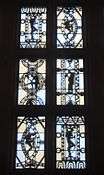 Rene Chambellan's metal window silhouettes
Rene Chambellan's metal window silhouettes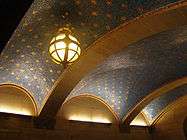 Globe light fixtures and vestibule mosaics
Globe light fixtures and vestibule mosaics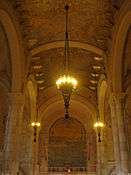 Interior with Breuckelen mosaic
Interior with Breuckelen mosaic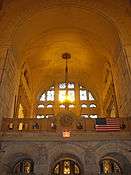 Mezzanine
Mezzanine Romanesque columns and the vault mosaics
Romanesque columns and the vault mosaics
References
Notes
- See:
- Emporis profile stating that building is 42 floors tall
- PropertySharks stating that building is 41 floors
- NY Observer Ad stating that building is 37 floors
Citations
- . The City of Williamsburgh was annexed by the City of Brooklyn in 1854, and the resulting neighborhood came to be called "Williamsburg", without the h.
- White, Norval; Willensky, Elliot & Leadon, Fran (2010). AIA Guide to New York City (5th ed.). New York: Oxford University Press. p. 637. ISBN 978-0-19538-386-7.
- "Lessons on Abandoned Observation Decks - part 1". All City New York. Retrieved December 15, 2009.
- "Lessons on Abandoned Observation Decks - part 2". All City New York. Retrieved December 23, 2009.
- "By the end of the 1920s the setback skyscraper, originally built in response to a New York zoning code, became a style that caught on from Chicago to Shanghai," observe Eric Peter Nash and Norman McGrath, discussing the "Williamsburgh Savings Bank Tower" in Manhattan Skyscrapers 2005:55.
- Newman, Andy. "A Tower of Dentists Wears a Golden Crown" The New York Times (September 20, 2002) accessed January 13, 2010
- Kahn, Eve M. "Profiting from History", Period Homes (November 2008)
- Nash and McGrath.
- Friedman, Joe. Inside New York: Discovering the Classic Interiors of New York 1998; 26, 125.
- "BANK ON CONDOS NBA GREAT IN $71M TOWER DEAL". NY Daily News.
- New York City Landmarks Preservation Commission; Dolkart, Andrew S.; Postal, Matthew A. (2009). Postal, Matthew A. (ed.). Guide to New York City Landmarks (4th ed.). New York: John Wiley & Sons. p. 246. ISBN 978-0-470-28963-1.
- Landmarks Preservation Commission July 19, 1994 accessed January 13, 2010
- "Lehman College Art Gallery: Architecture/Emigrant Savings Bank".
- The architectural and real estate development firm formed in 1920 by the developer Hayward S. Halsey with Thomas Bruce Boyd was renamed Halsey, Cormack and Helmer in 1925, when Halsey took into partnership the well-connected former banker George H. McCormack, and the architect Robert Helmer, who was primarily responsible for the design office.[12] The firm made a reputation for their moderately progressive bank buildings; aside from the Williamsburgh Savings Bank Tower, they are noted for the Dollar Savings Bank, on the Bronx's Grand Concourse (1932–33, landmarked 1994)[13] and Greenwich Savings Bank, 3–5 West 57th Street (1947); the firm was absorbed by Mancini•Duffy in 1967.
- Christopher Gray, "Streetscapes: Williamsburgh Savings Bank; Resolving the Case of Missing Muntins", The New York Times, November 12, 1989.
- "A Landmark Restored, From Mosaic Marble Floor to Grand Dome", The New York Times", March 13, 2014
- "Noyack Medical Partners Snags Office Condo". Daily News.
- Ames, Jonathan. "Entry 4" Slate (July 17, 2003)
Sources
External links
| Wikimedia Commons has media related to Williamsburgh Savings Bank Tower. |